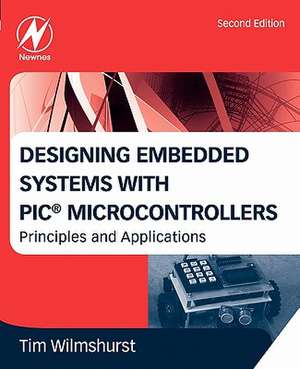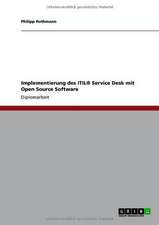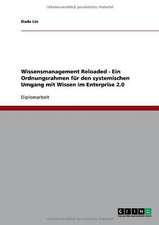Designing Embedded Systems with PIC Microcontrollers: Principles and Applications
Autor Tim Wilmshursten Limba Engleză Paperback – 20 noi 2009
This book takes the novice from introduction of embedded systems through to advanced development techniques for utilizing and optimizing the PIC family of microcontrollers in your device. To truly understand the PIC, assembly and C programming language must be understood. The author explains both with sample code and examples, and makes the transition from the former to the latter an easy one. This is a solid building block for future PIC endeavors.
New to the 2nd Edition:
*Include end of chapter questions/activities moving from introductory to advanced
*More worked examples
*Includes PowerPoint slides for instructors
*Includes all code snips on a companion web site for ease of use
*A survey of 16/32-bit PICs
*A project using ZigBee
- Covers both assembly and C programming languages, essential for optimizing the PIC
- Amazing breadth of coverage moving from introductory to advanced topics covering more and more complex microcontroller families
- Details MPLAB and other Microchip design tools
Preț: 224.76 lei
Preț vechi: 325.43 lei
-31% Nou
Puncte Express: 337
Preț estimativ în valută:
43.01€ • 44.90$ • 35.59£
43.01€ • 44.90$ • 35.59£
Carte tipărită la comandă
Livrare economică 29 martie-12 aprilie
Livrare express 01-07 martie pentru 96.32 lei
Preluare comenzi: 021 569.72.76
Specificații
ISBN-13: 9781856177504
ISBN-10: 1856177505
Pagini: 704
Ilustrații: black & white illustrations, black & white tables, figures
Dimensiuni: 191 x 235 x 34 mm
Greutate: 1.25 kg
Ediția:2 Rev ed.
Editura: ELSEVIER SCIENCE
Locul publicării:United Kingdom
ISBN-10: 1856177505
Pagini: 704
Ilustrații: black & white illustrations, black & white tables, figures
Dimensiuni: 191 x 235 x 34 mm
Greutate: 1.25 kg
Ediția:2 Rev ed.
Editura: ELSEVIER SCIENCE
Locul publicării:United Kingdom
Public țintă
Beginner or intermediate engineers new to PICs from the following areas: Field applications, software, hardware, systems, mechatronics. Upper-level undergrad students; lower-level graduate students. Advanced hobbyists.Cuprins
SECTION I: GETTING STARTED WITH EMBEDDED SYSTEMSChapter 1: Tiny Computers, Hidden ControlSECTION II: MINIMUM SYSTEMS AND THE PIC16F84AChapter 2: Introducing the PIC 16 series, and the 16F84AChapter 3: Parallel Ports, Power Supply, and the Clock OscillatorChapter 4: Starting to Program - An Introduction to AssemblerChapter 5: Building Assembler ProgramsChapter 6: Working with Time: Interrupts, Counters, and Timers UnchangedSECTION III: LARGER SYSTEMS AND TEH PIC16F883AChapter 7: Larger Systems and the PIC 16883AChapter 8: The Human and Physical InterfaceChapter 9: Taking Timing FurtherChapter 10: Starting with SerialChapter 11: Data Acquisition and ManipulationSECTION IV: SMARTER SYSTEMS AND THE PIC18XX2Chapter 12: Smarter Systems and the PIC 18FXX2Chapter 13: The PIC 18FXX2 PeripheralsChapter 14: Introducing CChapter 15: C and the Embedded EnvironmentChapter 16: Acquiring and Using Data with CChapter 17: More C and the Wider C environmentChapter 18: Multi-tasking and the Real Time Operating SystemChapter 19: The Salvo Real Time Operating SystemSECTION V: TECHNIQUES OF CONNECTIVITY AND NETWORKINGChapter 20: Connectivity and NetworksChapter 21: A Zigbee projectChapter 22: A Survey of 16/32 bit PIC Microcontrollers, and DSPICAppendix 1: The PIC 16 Series Instruction SetAppendix 2: The Electronic Ping-PongAppendix 3: The Derbot AGV ? Hardware Design DetailsAppendix 4: Some Basics of Autonomous Guided VehiclesAppendix 5: PIC 18 Series Instruction Set (Non-Extended)Appendix 6: Essentials of C

























